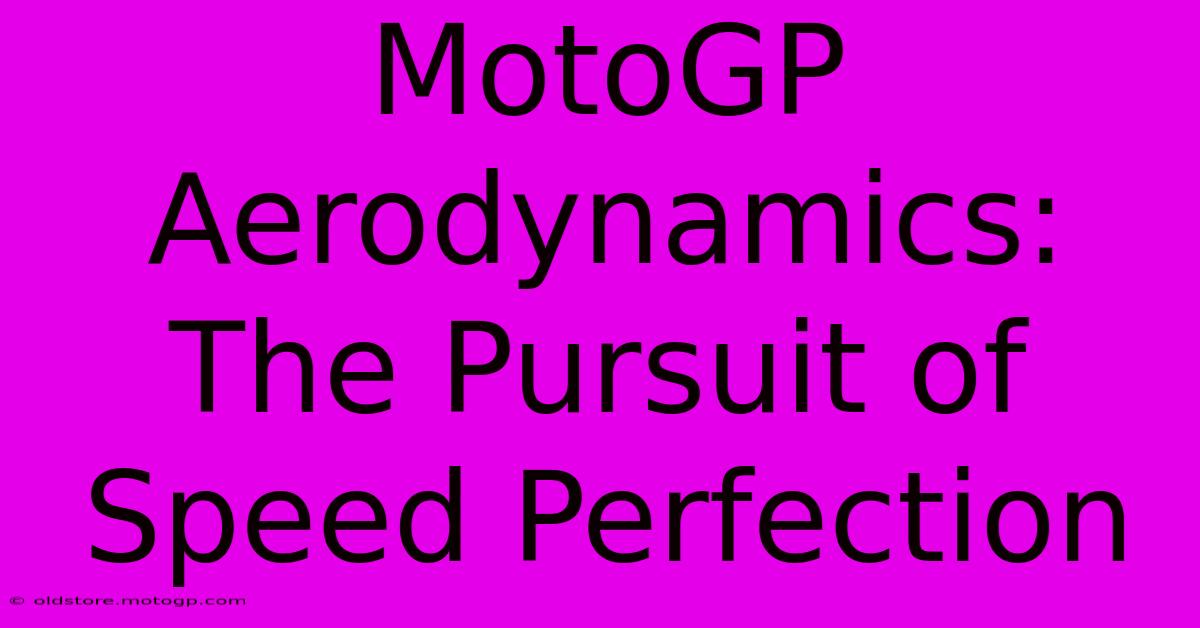MotoGP Aerodynamics: The Pursuit Of Speed Perfection

Table of Contents
MotoGP Aerodynamics: The Pursuit of Speed Perfection
MotoGP, the pinnacle of motorcycle racing, is a relentless pursuit of speed and performance. Every tenth of a second counts, and advancements in aerodynamics play a crucial role in achieving this razor-thin margin of victory. This article delves into the complex world of MotoGP aerodynamics, exploring the science behind the wings, winglets, and other aerodynamic devices that shape the performance of these incredible machines.
The Science of Speed: Understanding MotoGP Aerodynamics
Aerodynamics in MotoGP isn't just about going fast; it's about managing forces to enhance stability, control, and ultimately, speed. The primary aerodynamic challenges faced by MotoGP bikes include:
- High-speed stability: At speeds exceeding 200 mph, maintaining stability is paramount. Aerodynamic devices help to keep the bike planted on the track, preventing high-speed wobbles or "tank slappers."
- Downforce generation: Downforce, the force pushing the bike towards the track, is critical for cornering. Increased downforce allows riders to brake later and lean harder into corners, significantly impacting lap times.
- Drag reduction: While downforce is essential, excessive drag slows the bike. Engineers strive to find the optimal balance between generating downforce and minimizing drag, maximizing straight-line speed.
- Handling and rider comfort: Aerodynamic components must not negatively affect the bike's handling. The components need to be carefully designed to avoid upsetting the bike’s balance and to provide the rider with a comfortable and controllable experience.
Aerodynamic Components: Wings, Winglets, and More
Several key aerodynamic components contribute to a MotoGP bike's overall performance:
- Wings: Large wings, often positioned at the front and rear, generate significant downforce. Their angle and shape are meticulously designed to optimize downforce at various speeds and track conditions.
- Winglets: Smaller, wing-like elements positioned strategically around the bike, winglets fine-tune the aerodynamic balance and help manage airflow. They often contribute to reducing drag in certain areas while enhancing downforce in others.
- Fairings: The entire bodywork of the bike is carefully sculpted to manage airflow. The shape of the fairing minimizes drag and directs airflow efficiently around the bike, reducing turbulence and improving stability.
- Underbody aerodynamics: This is a critical but often overlooked aspect. The design of the underbody significantly impacts downforce and drag. Clever designs can channel air effectively to maximize downforce and minimize drag.
The Constant Evolution of MotoGP Aerodynamics
MotoGP aerodynamics is a constantly evolving field. Teams and manufacturers are continually experimenting with new designs and materials to gain a competitive edge. Computational Fluid Dynamics (CFD) plays a crucial role in this process, allowing engineers to simulate and analyze aerodynamic performance before testing on the track.
Wind tunnel testing remains essential, providing real-world data to validate CFD simulations and refine designs. This iterative process of simulation, testing, and refinement is critical to staying ahead of the competition.
The future of MotoGP aerodynamics promises even more sophisticated designs, potentially incorporating active aerodynamic elements that adjust in real-time to optimize performance across varying track conditions. This will lead to even faster lap times and more intense racing.
Conclusion: A Symphony of Speed and Science
MotoGP aerodynamics is a fascinating blend of science, engineering, and artistry. The pursuit of speed perfection requires a deep understanding of complex airflow dynamics and the ability to translate that knowledge into innovative designs. The constant evolution of this technology promises to keep MotoGP racing thrilling and unpredictable for years to come. The relentless quest for even marginal gains demonstrates the dedication and innovation at the heart of this remarkable motorsport.

Thank you for visiting our website wich cover about MotoGP Aerodynamics: The Pursuit Of Speed Perfection. We hope the information provided has been useful to you. Feel free to contact us if you have any questions or need further assistance. See you next time and dont miss to bookmark.
Featured Posts
-
The Art Of Racing Grand Prix Red Bulls Mastery
Feb 25, 2025
-
Cota Qualifying F1s Electrifying Qualifying
Feb 25, 2025
-
The V 4 Yamaha Built To Last
Feb 25, 2025
-
Cota Gifts Celebrate The Speed Celebrate The Memories
Feb 25, 2025
-
Get Closer To The Action With Club Si Austin F1
Feb 25, 2025
